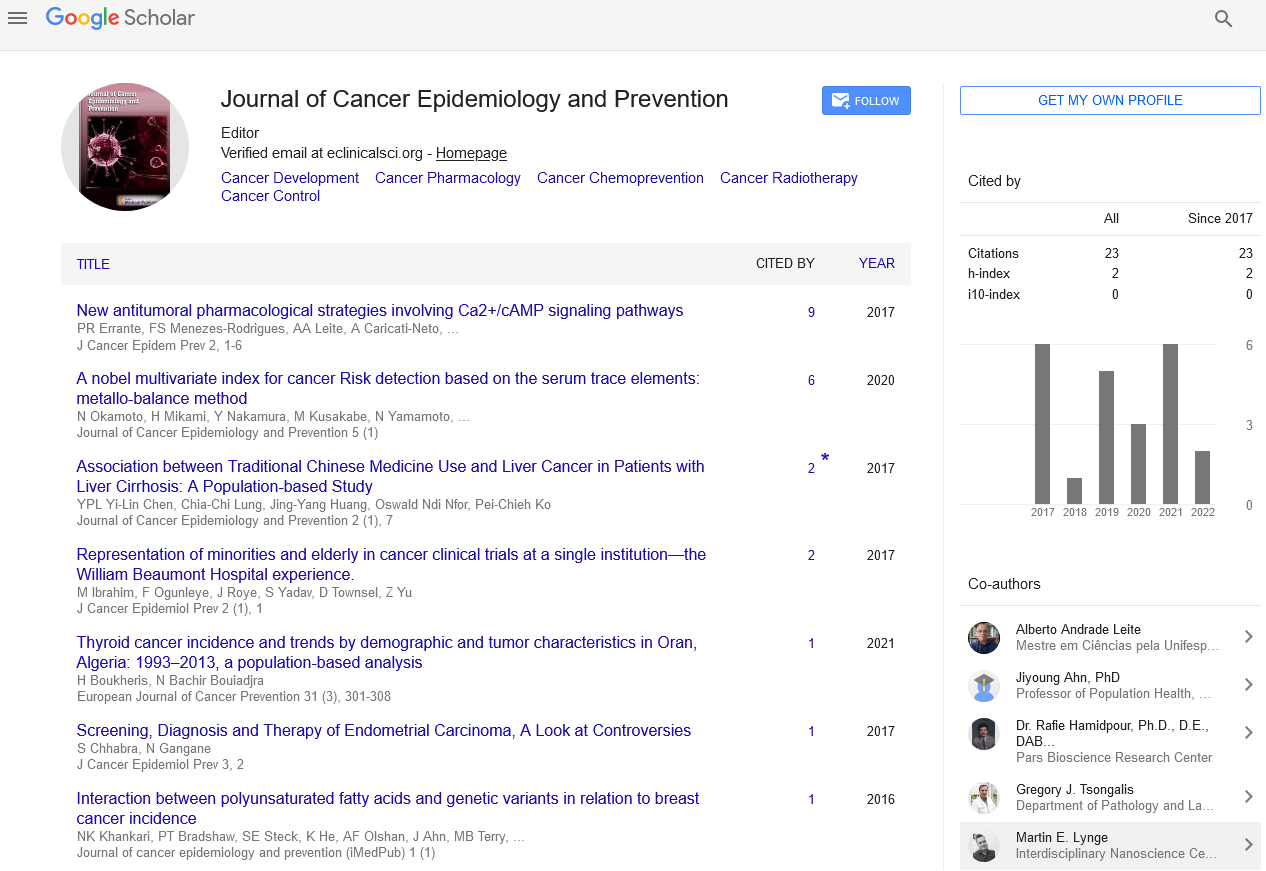Commentary - (2024) Volume 9, Issue 2
Cancer Control Strategies: A Comprehensive Approach to Combatting a Global Health Challenge
Javier Grajeda*
Department for Medical Statistics, Institute of Clinical Biometrics, Austria
*Correspondence:
Javier Grajeda,
Department for Medical Statistics, Institute of Clinical Biometrics,
Austria,
Email:
Received: 29-May-2024, Manuscript No. IPJCEP-24-20852;
Editor assigned: 31-May-2024, Pre QC No. IPJCEP-24-20852 (PQ);
Reviewed: 14-Jun-2024, QC No. IPJCEP-24-20852;
Revised: 19-Jun-2024, Manuscript No. IPJCEP-24-20852 (R);
Published:
26-Jun-2024, DOI: 10.36648/IPJCEP.9.2.20
Introduction
Cancer remains one of the leading causes of morbidity and
mortality worldwide, accounting for millions of deaths each
year. As the global burden of cancer continues to rise, it
becomes increasingly crucial to implement effective cancer
control strategies. These strategies encompass a range of
interventions designed to prevent cancer, detect it early, provide
timely treatment, and improve the quality of life for cancer
patients. This article explores the multifaceted approach to
cancer control, highlighting key strategies and their importance
in reducing the impact of this devastating disease. Primary
prevention aims to reduce the incidence of cancer by addressing
modifiable risk factors. This involves lifestyle changes, public
health interventions, and policies that minimize exposure
to carcinogens. Tobacco use is the leading preventable cause
of cancer. Comprehensive tobacco control policies include.
Increasing taxes on tobacco products to reduce affordability and
consumption. Implementing and enforcing laws that prohibit
smoking in public places to protect non-smokers from second
hand smoke. Raising awareness about the dangers of smoking
and promoting smoking cessation programs. A healthy diet
and regular physical activity are crucial in reducing cancer risk.
Promoting dietary guidelines that emphasize the consumption
of fruits, vegetables, whole grains, and lean proteins while
reducing the intake of processed foods, red meat, and sugary
beverages.
Description
Encouraging regular physical activity through community
programs, workplace initiatives, and public campaigns.
Excessive alcohol consumption is linked to several types of
cancer. Measures to control alcohol use include. Implementing
policies that limit alcohol availability and increase prices through
taxation. Educating the public about the cancer risks associated
with alcohol consumption. Certain infections are known to
cause cancer. Vaccination programs can prevent these infections
and reduce cancer risk. HPV vaccines prevent cervical, anal, and
other cancers caused by HPV. Vaccinating against hepatitis B
virus (HBV) can prevent liver cancer. Early detection of cancer
significantly improves treatment outcomes and survival rates.
Secondary prevention strategies focus on screening and early
diagnosis. Screening involves testing asymptomatic individuals
to identify early signs of cancer. Effective screening programs
include. Mammography is recommended for women aged 50-
74, with considerations for earlier screening based on individual
risk factors.
Conclusion
Utilizing various media platforms to disseminate information
about cancer screening and its benefits. Tertiary prevention
focuses on the treatment and management of cancer to improve
patient outcomes and quality of life. A multidisciplinary approach
to cancer treatment involves collaboration among various
healthcare professionals, including oncologists, surgeons,
radiologists, and palliative care specialists. This approach
ensures comprehensive care for patients. Strengthening
healthcare systems to provide adequate facilities and resources
for cancer treatment. Expanding insurance coverage to reduce
financial barriers to cancer care. Utilizing telemedicine to
provide remote consultations and follow-up care, particularly
in underserved areas. Continual advancements in cancer
treatment contribute to improved survival rates. Developing
drugs that target specific molecular pathways involved in cancer
growth.
Acknowledgement
None.
Conflict Of Interest
The author’s declared that they have no conflict of interest.
Citation: Grajeda J (2024) Cancer Control Strategies: A Comprehensive Approach to Combatting a Global Health Challenge. J Cancer Epidemiol Prev. 9:20.
Copyright: © 2024 Grajeda J. This is an open-access article distributed under the terms of the Creative Commons Attribution License, which permits unrestricted use, distribution, and reproduction in any medium, provided the original author and source are credited.

